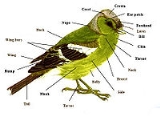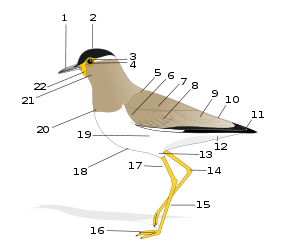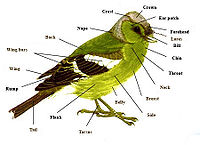
List of terms used in bird topography
Encyclopedia
Plumage features


- BackBack- People :* Adam Back, British cryptographer* Charles Back, South African winemaker* Chris Back , Australian politician* Ernst Emil Alexander Back , German physicist* Frédéric Back , Canadian animator...
- Belly
- BreastBreastThe breast is the upper ventral region of the torso of a primate, in left and right sides, which in a female contains the mammary gland that secretes milk used to feed infants.Both men and women develop breasts from the same embryological tissues...
- CheekCheekCheeks constitute the area of the face below the eyes and between the nose and the left or right ear. They may also be referred to as jowls. "Buccal" means relating to the cheek. In humans, the region is innervated by the buccal nerve...
- ChinChinIn the human anatomy, the chin is the lowermost part of the face.It is formed by the lower front of the mandible.People show a wide variety of chin structures. See Cleft chin....
- Crest
- CrownCrown (anatomy)A crown is the top of the head.The following birds and other animals are said to have a crown on their head:* Cranes** Grey-crowned Crane** Red-crowned Crane** Black-crowned Crane* Crowned eagle* Gray-crowned Rosy Finch* Yellow-crowned Gonolek...
- Crown patch
- Ear-coverts
- Eye ring
- Eyestripe (or eye line)
- FeatherFeatherFeathers are one of the epidermal growths that form the distinctive outer covering, or plumage, on birds and some non-avian theropod dinosaurs. They are considered the most complex integumentary structures found in vertebrates, and indeed a premier example of a complex evolutionary novelty. They...
, see category: :Category:Feathers - Flanks
- Forecrown
- Gorget
- Hood (or half-hood)
- Lateral throat stripe
- Lores
- MalarCheekCheeks constitute the area of the face below the eyes and between the nose and the left or right ear. They may also be referred to as jowls. "Buccal" means relating to the cheek. In humans, the region is innervated by the buccal nerve...
- Mantle
- Mask
- Moustachial stripe
- NapeNapeThe nape is the back of the neck. In technical anatomical/medical terminology, the nape is referred to by the word nucha, which also gives the adjective corresponding to "nape" in English, "nuchal"....
- Nuchal collar
- Operculum (on pigeons).
- Postocular stripe
- Remiges
- RumpRump-Politics:*Rump cabinet*Rump legislature*Rump organization*Rump Parliament*Rump Senate*Rump state*Rump party- Technology :* Runnable Userspace Meta Programs, software run in userspace that offers kernel functionality ....
- Spectacles
- Submoustachial stripe
- SuperciliumSuperciliumThe supercilium is a plumage feature found on the heads of some bird species. It is a stripe which runs from the base of the bird's beak above its eye, finishing somewhere towards the rear of the bird's head. Also known as an "eyebrow", it is distinct from the eyestripe, which is a line which runs...
- Supraloral
- Parts of the tailTailThe tail is the section at the rear end of an animal's body; in general, the term refers to a distinct, flexible appendage to the torso. It is the part of the body that corresponds roughly to the sacrum and coccyx in mammals, reptiles, and birds...
include:- Retrices
- Tail corner
- Terminal band
- Subterminal band
- ThroatThroatIn vertebrate anatomy, the throat is the anterior part of the neck, in front of the vertebral column. It consists of the pharynx and larynx...
- Undertail coverts
- Upper mandible (or maxilla)
- Uppertail coverts
- Vent or cloacaCloacaIn zoological anatomy, a cloaca is the posterior opening that serves as the only such opening for the intestinal, reproductive, and urinary tracts of certain animal species...
- Vent band
- Parts of the wingWingA wing is an appendage with a surface that produces lift for flight or propulsion through the atmosphere, or through another gaseous or liquid fluid...
s include:- AlulaAlulaThe alula, or bastard wing, is a small projection on the anterior edge of the wing of modern birds. The alula is the freely moving first digit, a bird's "thumb," and is typically covered with three to five small feathers, with the exact number depending on the species...
- Apical spot
- Axillar
- Bend of wing
- Carpal covert
- Emargination
- Greater coverts
- Leading edge of wing
- Lesser coverts
- Marginal coverts
- Median coverts
- Mirror (on gulls)
- Primaries
- Primary projection
- Primary numbers (e.g. 1, 2, 3, etc.)
- Scapulars
- Scapular crescent (on gulls)
- Secondaries
- SpeculumSpeculum feathersThe speculum is a patch, often distinctly coloured, on the inner remiges of some birds.Examples of the colour of the speculum in a number of ducks are:* Common Teal and Green-winged Teal: Iridescent green edged with buff....
- Tertials
- Terial step (on gulls)
- Trailing edge of wing
- Upper scapulars
- Wing bar
- Wing coverts
- Wing edging
- Wing linings
- Wing tip
- Alula
Bare-parts features
- Beak or billBeakThe beak, bill or rostrum is an external anatomical structure of birds which is used for eating and for grooming, manipulating objects, killing prey, fighting, probing for food, courtship and feeding young...
- CereCèreThe Cère is a long river in south-western France, left tributary of the Dordogne River. Its source is in the south-western Massif Central, near the mountain Plomb du Cantal...
- Culmen
- GapeGapeIn bird anatomy, the gape is the interior of the open mouth of a bird and the gape flange is the region where the two mandibles join together, at the base of the beak...
- Gonys
- Gonydeal angle
- Gonydeal spot
- Nail (of beak)
- Nares
- Rhamphotheca
- Gnathotheca
- Rhinotheca
- Tomia
- Cere
- Comb, or CoxcombComb (anatomy)Anatomically, a comb is a fleshy growth, caruncle, or crest on the top of the head of gallinaceous birds, most notably turkeys, pheasants, and domestic chickens...
- Orbital skin
- TarsusTarsus (skeleton)In tetrapods, the tarsus is a cluster of articulating bones in each foot situated between the lower end of tibia and fibula of the lower leg and the metatarsus. In the foot the tarsus articulates with the bones of the metatarsus, which in turn articulate with the bones of the individual toes...
- TibiaTibiaThe tibia , shinbone, or shankbone is the larger and stronger of the two bones in the leg below the knee in vertebrates , and connects the knee with the ankle bones....
- WattleWattle (anatomy)A wattle is a fleshy dewlap or caruncle hanging from various parts of the head or neck in several groups of birds, goats and other animals. In some birds the caruncle is erectile tissue.The wattle is frequently an organ of sexual dimorphism...

